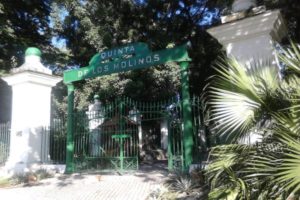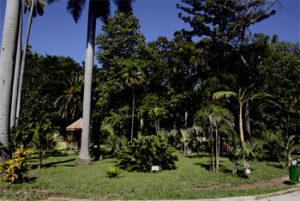 LA HABANA Y “LA QUINTA DE LOS MOLINOS” HERENCIA HISTÓRICA CUBANA.
LA HABANA Y “LA QUINTA DE LOS MOLINOS” HERENCIA HISTÓRICA CUBANA.
La Quinta de los Molinos es un monumento nacional situado en la ciudad de La Habana, Cuba. Importante por haber sido la residencia de los Capitanes Generales durante el período colonial, residencia del prócer Máximo Gómez y por albergar hoy el Jardín botánico de La Habana y el Museo Máximo Gómez.
Es llamado La Quinta de los Molinos debido a la antigua existencia de 2 molinos utilizados para moler tabaco y obtener rapé, de mucha demanda a finales del siglo XVIII en toda Europa, y en particular en España; que se consumía colocando un poco bajo la nariz y absorbiendo o respirando el aroma, así también como picadura de tabaco para fumar en las pipas. Los molinos eran propiedad de Martín de Aróstegui, presidente de la Real Factoría de Tabaco perteneciente al rey español, de ahí su nombre.
Desde 1835 y hasta el fin de la colonización española, funcionó como Casa de Verano de los Capitanes Generales que gobernaron la isla. Más tarde, en 1839, se fundó allí el primer Jardín Botánico Nacional. Y hacia 1899, con el arribo de los mambises a La Habana, fue la residencia del Generalísimo Máximo Gómez.
La Quinta de los Molinos, ubicada en la avenida de Carlos III, en el municipio Plaza de la Revolución, con abundante flora, constituye un sitio ideal para disfrutar de aire puro.
Los niños de mi generación encontraron en la Quinta de los Molinos un lugar de sano esparcimiento. Las puertas de la instalación siempre estaban abiertas, y los infantes admiraban las variedades de arbustos, contemplaban los estanques llenos de peces, además de disfrutar de una aceptable oferta gastronómica.
Permaneció cerrado durante varios años.
Pasó el tiempo, pero aún podíamos llevar a nuestros hijos a las actividades infantiles que se celebraban los fines de semana, así como visitar el Museo Máximo Gómez, que atesoraba pertenencias del viejo mambí. Después de ser nombrado el señor Eusebio Leal como administrador, con su equipo de la Oficina del Historiador de la Ciudad el lugar fue sometido a una remodelación general.
Con un tesoro natural en el que predominan las especies de porte arbóreo, seguidas por las herbáceas y en un menor grado las arbustivas, así como las especies de la fauna silvestre, el Jardín Quinta de los Molinos es el escenario de varias acciones que facilita la apertura de nuevos espacios para el quehacer de investigadores del campo de la biología y el desarrollo de la educación ambiental de los visitantes del Jardín.
El programa de desarrollo ambiental comunitario comprende también el diseño de servicios de información científico-técnica, cursos de superación y talleres, así como diversas propuestas culturales. Entre sus espacios, sobresalen un Centro Comunitario de Información Ambiental y su aula ecológica, el Pabellón Cultural, los senderos ecológicos, las exposiciones de miniecosistemas, los viveros de reproducción, los estanques, las fuentes, los acuarios, y el Centro para el Desarrollo de la Educación Ambiental con su sala temática de proyecciones.
Aunque no todas sus áreas se encuentran disponibles para el disfrute de los visitantes, la Quinta de los Molinos se reveló como uno de los escenarios del proyecto ‘Rutas y Andares’, organizado por la Oficina del Historiador. Decenas de familias pudieron apreciar el patrimonio histórico y las riquezas naturales que encierra este hermoso sitio, privilegiado por la existencia de unas 170 especies vegetales, de ellas algunas endémicas de la flora cubana; así como más de 66 especies de la fauna silvestre asociada a la vegetación, entre ellas moluscos, anfibios, reptiles, aves y mamíferos.
El Futuro de la histórica Quinta de los Molinos se espera que será una suerte de oasis en medio del bullicio de una ciudad que poco a poco nos sorprende con el renacer de sitios cargados de historia, más allá de La Habana Vieja.

LA HAVANA AND “LA QUINTA DE LOS MOLINOS” CUBAN HISTORICAL HERITAGE.
The Quinta de los Molinos is a national monument located in the city of Havana, Cuba. Important for having been the residence of the General Captains during the colonial period, residence of the hero Máximo Gómez and for housing today the Botanical Garden of Havana and the Máximo Gómez Museum.
It is called La Quinta de los Molinos due to the ancient existence of 2 mills used to grind tobacco and obtain snuff, which was in great demand at the end of the 18th century throughout Europe, and particularly in Spain; that was consumed by placing a little under the nose and absorbing or breathing the aroma, as well as sting of tobacco to smoke in the pipes. The mills were owned by Martín de Aróstegui, president of the Royal Tobacco Factory belonging to the Spanish king, hence its name.
From 1835 until the end of Spanish colonization, it functioned as the Summer House of the General Captains who ruled the island. Later, in 1839, the first National Botanical Garden was founded there. And towards 1899, with the arrival of the mambises to Havana, it was the residence of Generalísimo Máximo Gómez.
The Quinta de los Molinos, located on Avenida de Carlos III, in the Plaza de la Revolución municipality, with abundant flora, is an ideal place to enjoy pure air.
The children of my generation found in the Quinta de los Molinos a place of healthy recreation. The doors of the installation were always open, and the infants admired the varieties of shrubs, contemplated the ponds full of fish, as well as enjoying an acceptable gastronomic offer.
It remained closed for several years.
Time passed, but we could still take our children to the children’s activities that were held on weekends, as well as visit the Máximo Gómez Museum, which hoarded the old mambí’s belongings. After being named Mr. Eusebio Leal as administrator, with his team from the Office of the City Historian, the place underwent a general remodeling.
With a natural treasure in which predominate tree species, followed by herbaceous and to a lesser extent shrubs, as well as wildlife species, the Quinta de los Molinos Garden is the scene of several actions that facilitates the opening of new spaces for the work of researchers in the field of biology and the development of environmental education for visitors to the Garden.
The community environmental development program also includes the design of scientific-technical information services, improvement courses and workshops, as well as various cultural proposals. Among its spaces, stand out a Community Center of Environmental Information and its ecological classroom, the Cultural Pavilion, the ecological footpaths, the exhibitions of miniecosistemas, the nurseries of reproduction, the ponds, the sources, the aquariums, and the Center for the Development of Environmental Education with its thematic screening room.
Although not all of its areas are available for the enjoyment of visitors, the Quinta de los Molinos was revealed as one of the stages of the ‘Rutas y Andares’ project, organized by the Office of the Historian. Dozens of families were able to appreciate the historical heritage and natural riches that this beautiful site encloses, privileged by the existence of some 170 plant species, some of them endemic to the Cuban flora; as well as more than 66 species of wildlife associated with vegetation, including mollusks, amphibians, reptiles, birds and mammals.
The Future of the historic Quinta de los Molinos is expected to be a kind of oasis amidst the bustle of a city that little by little surprises us with the rebirth of places steeped in history, beyond Old Havana.
Agencies/Wiki/Cubanet/Orlando Freire/ Internet Photos/ Arnoldo Varona/ www.TheCubanHistory.com
THE CUBAN HISTORY, HOLLYWOOD.







